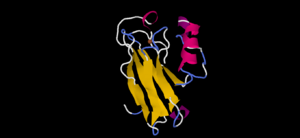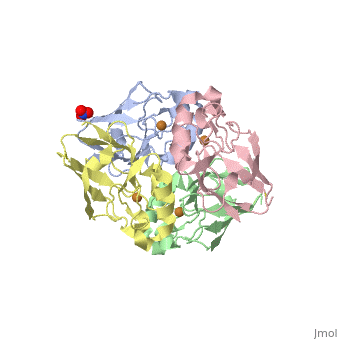User:Scot Wherland/Sandbox 1
From Proteopedia
< User:Scot Wherland(Difference between revisions)
| (6 intermediate revisions not shown.) | |||
| Line 1: | Line 1: | ||
| - | [[Image:4AZUa.png|300px|left|thumb| Ps. aer Azurin]] <Structure load='4AZU' size='400' frame='true' align='right' caption='Ps. aer Azurin' scene='Insert optional scene name here' /> | + | [[Image:4AZUa.png|300px|left|thumb| Ps. aer Azurin]] |
| + | <StructureSection> | ||
| + | <Structure load='4AZU' size='400' frame='true' align='right' caption='Ps. aer Azurin' scene='Insert optional scene name here' /> | ||
| + | |||
== Introduction == | == Introduction == | ||
| Line 13: | Line 16: | ||
The studies discussed here involve the intramolecular electron transfer between a one electron reduced disulfide radical and the oxidized copper ion. In order to measure the rate constant for this process, the disulfide radical must be produced rapidly by a strong reductant in a bimolecular reaction. This bimoleclar reaction must reduce the disulfide preferentially over the Cu<sup>2+</sup> site. Azurin shows this preferential reactivity due to the lack of exposure of the copper site, with only part of the edge of the His117 exposed coupled with high exposure of the disulfide Cys3-Cys26. | The studies discussed here involve the intramolecular electron transfer between a one electron reduced disulfide radical and the oxidized copper ion. In order to measure the rate constant for this process, the disulfide radical must be produced rapidly by a strong reductant in a bimolecular reaction. This bimoleclar reaction must reduce the disulfide preferentially over the Cu<sup>2+</sup> site. Azurin shows this preferential reactivity due to the lack of exposure of the copper site, with only part of the edge of the His117 exposed coupled with high exposure of the disulfide Cys3-Cys26. | ||
| - | <scene name='45/458437/Azurinsitessexposuretop/3'>Site from top </scene> <scene name='45/458437/Azurinsitessexposurebottom/ | + | <scene name='45/458437/Azurinsitessexposuretop/3'>Site from top </scene> |
| + | <scene name='45/458437/Azurinsitessexposurebottom/9'> Disulfide from Bottom</scene> The reducing agent typically used is the CO<sub>2</sub><sup>-</sup> radical, an especially strong reducing agent produced by pulse radiolysis of formate containing solutions. | ||
== Electron transfer path == | == Electron transfer path == | ||
Electron transfer is slowed by distance between the donor and acceptor, but this can be partially ameliorated by an appropriately constructed pathway of covalent bonds. Thus the distance between the electron donor and acceptor can be analyzed in terms of pathways involving covalent bonds, hydrogen bonds (less effective), and through-space jumps (even less effective). One pathway between the disulfide and copper involves a covalent path from SG of Cys 3, through the backbone Ser 4, Val 5, Asp 6, Ile 7, Gln 8, Gly 9 and Asn 10, then through a hydrogen bond from the O of Asn 10 to the proton on NE2 (Ne) of the ligand His46. The second path branches through a hydrogen bond from the carbonyl O of Cys 3 to the peptide N of Thr 30, then through the backbone of Val 31 and then via a through-space jump from the side chain CG of Val 31 to CG of the sidechain of Trp 48, then through the side chain and backbone of Trp 48 and Val 49, followed by a hydrogen bond from the backbone N of Val 49 to to carbonyl O of Phe 111 and then to the Cu via the ligand Cys 112. The orbital coupling provide by this path is sensitive to the distance of the through-space jump, and thus is influenced by the mobility of the structure. <scene name='User:Scot_Wherland/Sandbox_1/Azurinpath1/1'>Path 1</scene> <scene name='User:Scot_Wherland/Sandbox_1/Azurinpath2/5'>Path 2</scene> | Electron transfer is slowed by distance between the donor and acceptor, but this can be partially ameliorated by an appropriately constructed pathway of covalent bonds. Thus the distance between the electron donor and acceptor can be analyzed in terms of pathways involving covalent bonds, hydrogen bonds (less effective), and through-space jumps (even less effective). One pathway between the disulfide and copper involves a covalent path from SG of Cys 3, through the backbone Ser 4, Val 5, Asp 6, Ile 7, Gln 8, Gly 9 and Asn 10, then through a hydrogen bond from the O of Asn 10 to the proton on NE2 (Ne) of the ligand His46. The second path branches through a hydrogen bond from the carbonyl O of Cys 3 to the peptide N of Thr 30, then through the backbone of Val 31 and then via a through-space jump from the side chain CG of Val 31 to CG of the sidechain of Trp 48, then through the side chain and backbone of Trp 48 and Val 49, followed by a hydrogen bond from the backbone N of Val 49 to to carbonyl O of Phe 111 and then to the Cu via the ligand Cys 112. The orbital coupling provide by this path is sensitive to the distance of the through-space jump, and thus is influenced by the mobility of the structure. <scene name='User:Scot_Wherland/Sandbox_1/Azurinpath1/1'>Path 1</scene> <scene name='User:Scot_Wherland/Sandbox_1/Azurinpath2/5'>Path 2</scene> | ||
| - | + | </StructureSection> | |
== See Also == | == See Also == | ||
== References == | == References == | ||
Current revision
| |||||||||||


